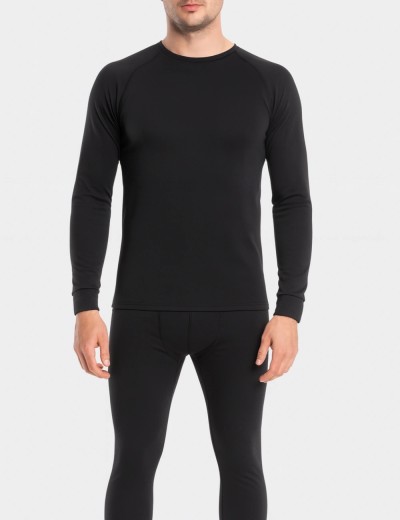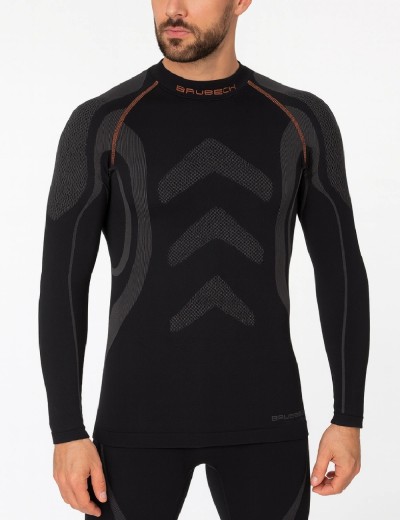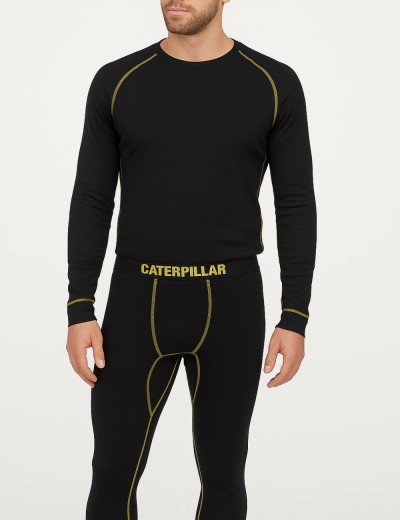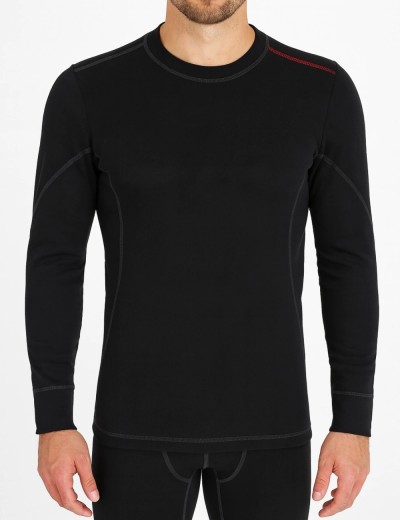- today
- perm_identity Igor z Balticbhp
- label Guide
- favorite 1 likes

Thermoactive Underwear – Everything You Need to Know About the Base Layer
Today we’ll talk about:
- ✅ why you need to understand what fabric breathability really means
- ✅ whether thicker always means better
- ✅ whether all polyester is the same — and which one to choose
And now you’re probably asking: “How do you know all this?” Here’s the answer — I’ve been working with technical clothing in practice and theory for over 10 years. I’m also an active user of this gear: I run, climb, work physically, and train. That allows me to combine theory with real-life experience… and turn it into simple, useful tips that actually work.
1️⃣ Understanding Breathability! Why Is Clothing Thermoactive?
The key to choosing the right clothing.
Common myths about base-layer clothing:
- ⛔ clothes generate heat
- ⛔ cotton breathes well
- ⛔ synthetic fabrics make you sweat
Yes, you read that right — clothing doesn’t generate heat, and cotton is a terrible choice for intense work. But let’s start with a bit of theory.
What does it mean that clothing “breathes”?
Breathability (not to be confused with air permeability) simply means moving moisture away from the skin.
Why does this happen?
Your body heats up while you work, your skin warms up, and so does your sweat. The sweat evaporates and moves into the base layer, and from there into the next layer (like a fleece). Effective moisture transport requires heat. That’s the whole secret.
Cotton – good only when you’re not working
Cotton clothes are breathable. If you sit or stand all day without effort — they’re perfect. But in real work you often get tired, sweat, move, and switch between environments (indoors ↔ outdoors).
Cotton is a disaster in those conditions. Why?
- it absorbs moisture extremely well
- but doesn’t release it at all
- it becomes cold and wet
Wet cotton – try a simple test
Put on a cotton T-shirt, warm up, and wet it. Sit down. After 5 minutes your skin will feel cold — the shirt won’t dry. Try the same with a good polyester shirt and you’ll see the difference.
The tasks of a base layer
- ➡️ drying
- ➡️ insulation
- ➡️ thermoregulation
What does “thermoactive clothing” really mean?
It doesn’t mean it heats or cools you. It reacts to changes in temperature and humidity to keep you:
- cooler in summer — but not cold
- warmer in winter — but not overheating
And what about winter?
No clothing (except battery-powered) generates heat. It can only insulate the heat you produce yourself.
Which material should you choose for a base layer?
The answer: it depends. The simplest rule:
the harder you work — the further you should stay from cotton
the colder it gets — the more you should rely on merino wool
Material comparison
| Material | Low intensity | Medium intensity | High intensity | Characteristics |
|---|---|---|---|---|
| Cotton | ✅ Comfortable and soft for low activity | ⚠️ Works only with moderate sweating | ❌ Traps sweat, becomes wet and cold | Natural and breathable, but dries slowly and doesn’t transport moisture. |
| Polyester (technical) – Coolmax®, Dryarn® | ⚠️ May feel cool during low activity | ✅ Good balance of comfort and dryness | ✅✅ Best choice for high-intensity work | Lightweight, quick-drying, excellent at moisture management. |
| Merino Wool | ✅ Keeps you warm even when you’re not moving | ✅ Comfortable and self-regulating | ✅ Very good, but can cause overheating under extreme effort | Premium natural material: “warms when cold, cools when warm”, soft, antibacterial, odor-resistant. |
2️⃣ Too Much of a Good Thing – Why More Doesn’t Mean Better
We often get emails like: “Recommend a warm, thick jacket for work in this or that condition.”
And right away, I have to say — I’m against that approach.
First: thicker doesn’t mean warmer.
Second: even if something is thick and warm, it’s usually less versatile and limits your ability to manage temperature.
When I go to the mountains with people, I often hear: “You’re always changing layers!”. Yes — I stop often to remove or add a layer. And what’s wrong with that? Effective thermal comfort comes from reacting to changing conditions.
⛔ One set for everything? The worst choice
The worst thing you can do is have only one base layer — for example, great merino — and use it for all conditions. It will never work.
Even though merino wool is one of the most universal materials.
💰 “But it’s expensive!”
Someone might say: “Come on, a thermal underwear set costs 25–100 EUR”. Well, and a doctor’s visit + medication + sick leave? That’s the real cost.
⚡️ BalticBHP Pro Tip:
Invest in two base-layer sets:
- ✔️ one polyester (technical — for medium and high activity)
- ✔️ one merino wool (for cold and low activity)
These two sets give you the greatest possible flexibility in managing temperature while working. Wear them depending on intensity and temperature — following the table above.
In practice:
For very high-intensity work, merino wool should only be used in truly cold conditions.
From my own experience: when I go ski touring uphill, I never wear merino — it’s simply too hot.
3️⃣ Not All Polyester Is Created Equal — How Not to Get Discouraged by Thermal Underwear
It’s not like you walk into a discount store, buy the cheapest “thermal underwear”, and expect to be happy with it. Unfortunately, polyester is not just polyester.
And here’s something I really love about the workwear and outdoor industry: in most cases, you really get what you pay for. It’s completely different from everyday casual fashion where you pay mostly for the logo, not functionality.
Coolmax® – an example that changes everything
Take a fabric like Coolmax®. It’s “just polyester”, right? So what’s the big deal?

The secret becomes visible only under strong magnification. Coolmax fibers have a special multi-channel cross-section, which allows them to:
- ✔️ transport moisture faster
- ✔️ warm up more easily from body heat
- ✔️ evaporate sweat more efficiently
That’s why I mentioned earlier that moisture transport requires heat.
So the question is: which fiber will warm up faster — a regular round one or a Coolmax® fiber designed specifically to move moisture? The answer is obvious.
It’s not just about the T-shirt
Today we focused on the base layer — shirts, leggings, underwear. But the same rules apply to:
- ✔️ socks
- ✔️ gloves
- ✔️ hats
- ✔️ neck warmers and scarves
If you understand the basics, you know exactly where to start this season — and you won’t waste money on things that don’t work.
The most important part
Seriously — if you want to buy thermal underwear, buy a good one. You need to feel the difference to truly understand how technical clothing works. Sure, everyone has their own budget limits, but if you want real comfort, dryness, and thermoregulation — choose quality. It’s an investment that pays off from the first day.




